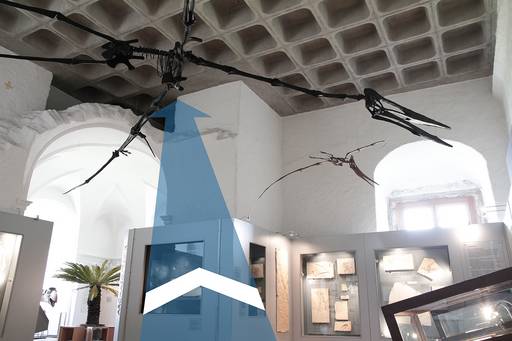This fossil looks strange: pointed teeth, a very small thorax, very long fingers and a long tail. It is a pterosaur. Its name Rhamphorhynchus means “beak-snout”.
The picture below explains this fossil in more detail.

© Jura-Museum Eichstätt
Kings of the skies
The beak-snout with the long finger
This fossil looks strange: pointed teeth, a very small thorax, very long fingers and a long tail. It is a pterosaur. Its name Rhamphorhynchus means “beak-snout”.
The picture below explains this fossil in more detail.
Rhamphorhynchus explained.
In the Jurassic period, dinosaurs just started to fly. The airspace above the Jurassic Sea was ruled by other animals: Pterosaurs like this Rhamphorhynchus had already learned to fly 60 million years earlier. These reptiles no longer exist today, we only know them as fossils. Particularly beautiful specimens come from the Altmühl Valley.
To be or not to be a dino, that is the question!
Pterosaurs were neither dinosaurs nor birds. They are a separate group within the reptiles. Find out which of these animals are dinosaurs and which represent independent reptile groups.
Giant of the skies
Rhamphorhynchus is among the larger Jurassic pterosaurs, but still looks cute compared to the giant above your head.

© Florian Sochatzy, Digitale Lernwelten GmbH
Look up at the large pterosaur above you.
This is a model of Quetzalcoatlus northropi, the largest known pterosaur and the largest known conqueror of the skies ever. Its wingspan was eleven meters. Despite this, the entire animal weighed only around 80 kilograms. This impressive size was only possible because its bones were hollow and filled with air – a reptile of lightweight construction. Its thin sternum indicates that it did not have a powerful wing beat: Pterosaurs mostly sailed above the seas. It also had three little fingers in front of the wing finger because it had to land and probably climb cliffs to lay its eggs there where they were protected from predators.
Quetzalcoatlus did not live in the Jurassic period, however, but 68 million years ago at the end of the Cretaceous period in North America. It is named after Quetzalcoatl, a deity of the Aztecs. This giant is one of many examples of how pterosaurs evolved after Jurassic times.